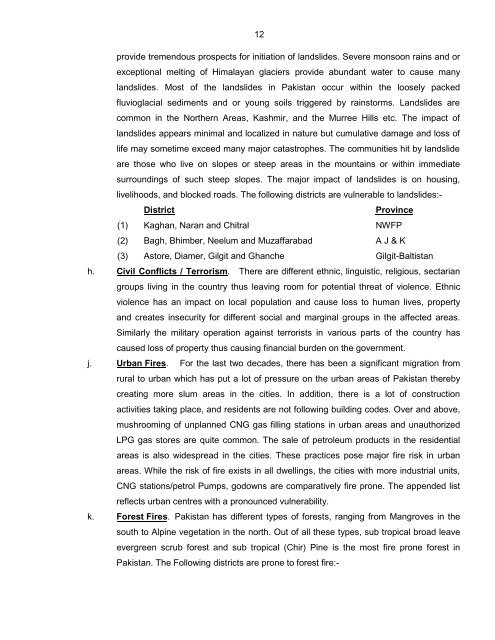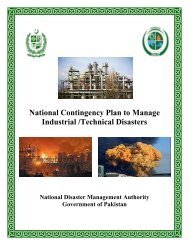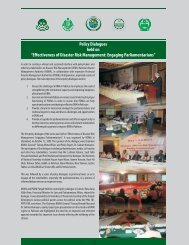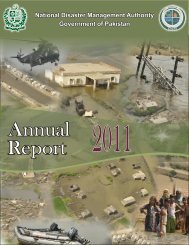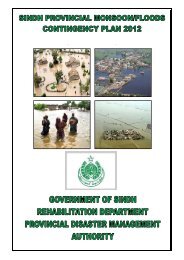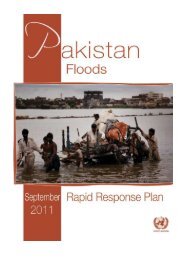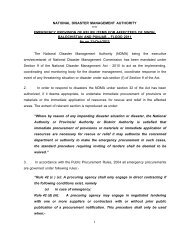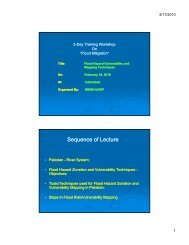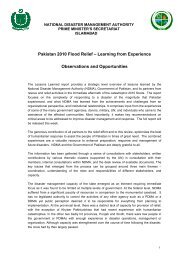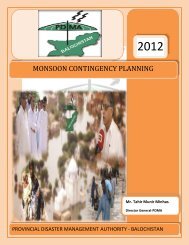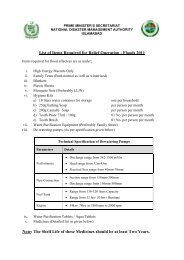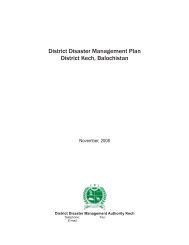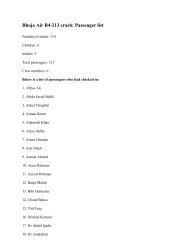National Disaster Response Plan (NDRP) March 2010 - NDMA
National Disaster Response Plan (NDRP) March 2010 - NDMA
National Disaster Response Plan (NDRP) March 2010 - NDMA
Create successful ePaper yourself
Turn your PDF publications into a flip-book with our unique Google optimized e-Paper software.
12<br />
provide tremendous prospects for initiation of landslides. Severe monsoon rains and or<br />
exceptional melting of Himalayan glaciers provide abundant water to cause many<br />
landslides. Most of the landslides in Pakistan occur within the loosely packed<br />
fluvioglacial sediments and or young soils triggered by rainstorms. Landslides are<br />
common in the Northern Areas, Kashmir, and the Murree Hills etc. The impact of<br />
landslides appears minimal and localized in nature but cumulative damage and loss of<br />
life may sometime exceed many major catastrophes. The communities hit by landslide<br />
are those who live on slopes or steep areas in the mountains or within immediate<br />
surroundings of such steep slopes. The major impact of landslides is on housing,<br />
livelihoods, and blocked roads. The following districts are vulnerable to landslides:-<br />
District Province<br />
(1) Kaghan, Naran and Chitral NWFP<br />
(2) Bagh, Bhimber, Neelum and Muzaffarabad A J & K<br />
(3) Astore, Diamer, Gilgit and Ghanche Gilgit-Baltistan<br />
h. Civil Conflicts / Terrorism. There are different ethnic, linguistic, religious, sectarian<br />
groups living in the country thus leaving room for potential threat of violence. Ethnic<br />
violence has an impact on local population and cause loss to human lives, property<br />
and creates insecurity for different social and marginal groups in the affected areas.<br />
Similarly the military operation against terrorists in various parts of the country has<br />
caused loss of property thus causing financial burden on the government.<br />
j. Urban Fires. For the last two decades, there has been a significant migration from<br />
rural to urban which has put a lot of pressure on the urban areas of Pakistan thereby<br />
creating more slum areas in the cities. In addition, there is a lot of construction<br />
activities taking place, and residents are not following building codes. Over and above,<br />
mushrooming of unplanned CNG gas filling stations in urban areas and unauthorized<br />
LPG gas stores are quite common. The sale of petroleum products in the residential<br />
areas is also widespread in the cities. These practices pose major fire risk in urban<br />
areas. While the risk of fire exists in all dwellings, the cities with more industrial units,<br />
CNG stations/petrol Pumps, godowns are comparatively fire prone. The appended list<br />
reflects urban centres with a pronounced vulnerability.<br />
k. Forest Fires. Pakistan has different types of forests, ranging from Mangroves in the<br />
south to Alpine vegetation in the north. Out of all these types, sub tropical broad leave<br />
evergreen scrub forest and sub tropical (Chir) Pine is the most fire prone forest in<br />
Pakistan. The Following districts are prone to forest fire:-


